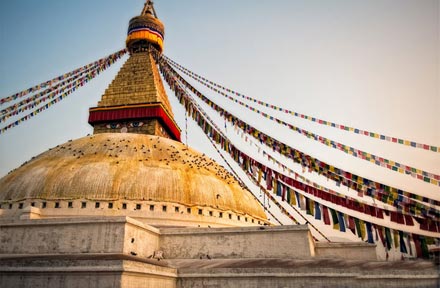The allure of the other
Susmita Baral, a non-Buddhist tours Lumbini in Nepal and tries to
find answers to the question: what compels travellers to visit centres
of faiths that are not their own?
Scattered across Asia, from India to South Korea, thousands of
Buddhist temples, monasteries, stupas and pagodas serve as places of
worship and reminders of the principles of Buddhism.But none of these
architectural gems hold the symbolic and historical value of Lumbini, a
province at the foot of the Himalayan Mountains in the Terai plains of
southern Nepal. One of four holy pilgrimage sites for the 488 million
Buddhists worldwide, this region marks the birthplace of Buddha, who was
born Prince Siddhartha Guatama in 623BC to King Suddhodhana and Queen
Maya Devi.
|

Boudhanath Stupa - one of the largest in Asia
-intlsherpaexpedition |
A World Heritage Site since 1997, Lumbini has attracted travellers
and worshippers for centuries. In 249 BC, Indian Emperor Ashoka visited
and left his tribute to Buddha: four stupas and a stone pillar with a
figure of a horse on top. After a period of neglect, the site was
rediscovered in 1896 by German archaeologist Alois Anton Führer and
later recognised as Buddha's birthplace based on the analysis of
archaeological remains.
Today, more than 400,000 travellers visit the sacred site each year,
wandering among the ruins of ancient monasteries and stupas. They walk
clockwise around Ashoka's stupas and stone pillar to pay homage, and
they explore the Maya Devi Temple, where it's believed that the queen
gave birth, bathing in a nearby pond beforehand.
And every April or May, during the first full month of Vaisakh, the
one-day Buddha Jayanti festival brings thousands to the region to
commemorate Buddha's birth, enlightenment and death through prayer and
meditation.
The big question
In addition to being such an important pilgrimage site, Lumbini also
attracts thousands of people of various backgrounds and denominations,
much like St Peter's Basilica in Vatican City, Angkor Wat in Cambodia,
and the Sultan Ahmed Mosque in Turkey. But what drives travellers to
visit religious hubs from faiths that are not their own? To find out,
researchers from Arizona State University (ASU) used Lumbini as a case
study in 2013, surveying visitors throughout the year on their
inspiration for visiting Buddha's birthplace.
"I was interested in understanding the motivation and experience of
people of different faiths visiting the same sites," said lead
researcher Dr Gyan P Nyaupane, associate professor at ASU's School of
Community Resources and Development.
According to the report, many of the Hindus and Christians that were
surveyed said they visited Lumbini because they found Buddhism to be
similar to their own respective faith. Many Hindus, for example, believe
that Buddha is a reincarnation of Vishnu, and ergo accept Lumbini to be
holy. A lot of Christians, on the other hand, see Buddhism to be
non-conflicting with their faith.
"While Buddhists have higher religious motivations - such as, to feel
close to Buddha and to pray - non-Buddhists have higher recreational,
learning and social motivations," Nyaupane explained.
Previous research published in the August 2009 issue of the Journal
of Heritage Tourism agreed, concluding that travellers are drawn to
sacred sites for four main reasons: they are world-renowned and globally
branded (like World Heritage Sites); they feature exemplary architecture
(such as the Sagrada Família); or they are associated with famous people
or events (like St Paul's Cathedral and the royal wedding). There's also
the spirituality component: many people find inner peace visiting
cultural and religious destinations.
Innate love
In my case, my visit was primarily driven by an innate love for
Buddhist temples. No cocktail of words can exactly encompass the
serenity and inexplicable feeling of harmony that I experience when
entering one; perhaps it's a product of the incense, the mild chanting
or my fascination with the eclectic styles of Buddhist architecture. But
after visiting countless Buddhist temples in India, Thailand and other
parts of the world, I imagined a trip to Buddha's birthplace would be
even more comforting.
As I explored the main Lumbini compound and walked the 2.1km route
from the Maya Devi Temple to the Lumbini Museum, I passed the numerous
temples and stupas that have been erected by nations around the world in
Buddha's honour.
I was left in awe, marvelling at Myanmar's eye-catching Golden
Temple, Thailand's ornate white marble Royal Thai Buddhist Monastery,
Vietnam's pagoda-style Phat Quoc Tu Temple with dragons on the roof, and
Germany's Lotus Stupa with its colourful frescos of Buddha's teachings.
By the time I reached the museum, which is filled with Buddhist
artefacts and photographs, I'd felt as though I'd taken a walk around
the world, experiencing the immense impact Buddhism has had on the
planet and its people. Much like visits to other sacred sites around the
world, the day had expanded my knowledge, broadened my awareness and
allowed me to cultivate greater tolerance.
After all, there is just something different about removing your
shoes before entering a temple, putting on a headscarf before entering a
mosque, or sitting silently in a church that brings forth a feeling of
solidarity with others around you.
(This article was originally
published in BBC Travel) |

